Town square
This article needs additional citations for verification. (September 2010) |


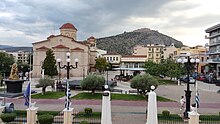
A town square (also a plaza, public square or urban square) is an open public space commonly found in the heart of a traditional town, and which is used for community gatherings. A square in a city may be called a city square. Related concepts are the civic center, the market square and the village green.
Most squares are hardscapes suitable for open markets, concerts, political rallies, and other events that require firm ground. They are not necessarily a true geometric square.
Being centrally located, town squares are usually surrounded by small shops such as bakeries, meat markets, cheese stores, and clothing stores. At their center is often a well, monument, statue or other feature. Those with fountains are sometimes called fountain squares.
The term "town square" (especially via the term "public square") is synonymous with the politics of many cultures, and the names of a certain town squares, such as the Euromaidan or Red Square, have become symbolic of specific political events throughout history.
Australia
[edit]The city centre of Adelaide and the adjacent suburb of North Adelaide, in South Australia, were planned by Colonel William Light in 1837. The city streets were laid out in a grid plan, with the city centre including a central public square, Victoria Square, and four public squares in the centre of each quarter of the city. North Adelaide has two public squares. The city was also designed to be surrounded by park lands, and all of these features still exist today, with the squares maintained as mostly green spaces.[1][2]
China
[edit]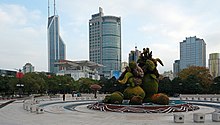
In Mainland China, People's Square is a common designation for the central town square of modern Chinese cities, established as part of urban modernization within the last few decades. These squares are the site of government buildings, museums and other public buildings. One such square, Tiananmen Square, is a famous site in Chinese history due to it being the site of the May Fourth Movement, the Proclamation of the People's Republic of China, the 1976 Tiananmen Incident, the 1989 Tiananmen Square Protests, and all Chinese National Day Parades.
Germany
[edit]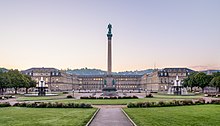
The German word for square is Platz, which also means "Place", and is a common term for central squares in German-speaking countries. These have been focal points of public life in towns and cities from the Middle Ages to today. Squares located opposite a Palace or Castle (German: Schloss) are commonly named Schlossplatz. Prominent Plätze include the Alexanderplatz, Pariser Platz and Potsdamer Platz in Berlin, Heldenplatz in Vienna, and the Königsplatz in Munich.
Indonesia
[edit]
A large open square common in villages, towns and cities of Indonesia is known as alun-alun. It is a Javanese term which in modern-day Indonesia refers to the two large open squares of kraton compounds. It is typically located adjacent a mosque or a palace. It is a place for public spectacles, court celebrations and general non-court entertainments.[citation needed]
Iran
[edit]
In traditional Persian architecture, town squares are known as maydan or meydan. A maydan is considered one of the essential features in urban planning and they are often adjacent to bazaars, large mosques and other public buildings. Naqsh-e Jahan Square in Isfahan and Azadi Square in Tehran are examples of classic and modern squares. Several countries use the term "maidan" across Eastern Europe and Central Asia, including Ukraine, in which the term became well-known globally during the Euromaidan.
Italy
[edit]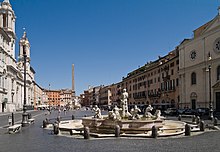
A piazza (Italian pronunciation: [ˈpjattsa]) is a city square in Italy, Malta, along the Dalmatian coast and in surrounding regions. Possibly influenced by the centrality of the Forum (Roman) to ancient Mediterranean culture, the piazze of Italy are central to most towns and cities. Shops, businesses, metro stations, and bus stops are commonly found on piazzas, and in multiple locations also feature Roman Catholic Churches, such as in places known as the Piazza del Duomo, with the most famous perhaps being at Duomo di Milan, or government buildings, such as the Piazza del Quirinale adjacent from the Quirinal Palace of the Italian president.
The Piazza San Marco in Venice and Piazza del Popolo in Rome are among the world's best known. The Italian piazzas historically played a major role in the political developments of Italy in both the Italian Medieval Era and the Italian Renaissance.[3] For example, the Piazza della Signoria in Florence remains synonymous with the return of the Medici from their exile in 1530 as well as the burning at the stake of Savonarola during the Italian Inquisition.[4]
The Italian term is roughly equivalent to the Spanish plaza, the French term place, the Portuguese praça, and the German Platz. Not to be confused, other countries use the phrase to refer to an unrelated feature of architectural or urban design, such as the "piazza" at King's Cross station in London or piazza as used by some in the United States, to refer to a verandah or front porch of a house or apartment,[5] such as at George Washington's historic home Mount Vernon.[6]
Several countries, especially around the Mediterranean Sea, feature Italian-style town squares. In Gibraltar, one such town square just off Gibraltar's Main Street, between the Parliament Building and the City Hall officially named John Mackintosh Square is referred to as The Piazza.
Netherlands and Belgium
[edit]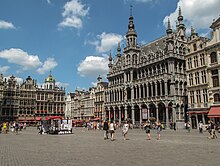
In the Low Countries, squares are often called "markets" because of their usage as marketplaces. Most towns and cities in Belgium and the southern part of the Netherlands have in their historical centre a Grote Markt (literally "Big Market") in Dutch or Grand-Place (literally "Grand Square") in French[7][8] (for example the Grand-Place in Brussels and the Grote Markt in Antwerp). The Grote Markt or Grand-Place is often the location of the town hall, hence also the political centre of the town. The Dutch word for square is plein, which is another common name for squares in Dutch-speaking regions (for example Het Plein in The Hague).
In the 17th and 18th centuries, another type of square emerged, the so-called royal square (French: Place royale, Dutch: Koningsplein). Such squares did not serve as a marketplace but were built in front of large palaces or public buildings to emphasise their grandeur, as well as to accommodate military parades and ceremonies, among others (for example the Place Royale in Brussels and the Koningsplein in Amsterdam). Palace squares are usually more symmetrical than their older market counterparts.[9]
Russia
[edit]
In Russia, central square (Russian: центра́льная пло́щадь, romanised: tsentráĺnaya plóshchad́) is a common term for an open area in the heart of the town.[citation needed] In a number of cities, the square has no individual name and is officially designated Central Square, for example Central Square (Tolyatti).[citation needed] The most famous central square is the monumentally-proportioned Red Square which became a synecdoche for the Soviet Union during the 20th century; nevertheless, the association with "red communism" is a back formation, since krásnaja (the term for "red") also means "beautiful" in archaic and poetic Russian, with many cities and towns throughout the region having locations with the name "Red Square."[citation needed]
South Korea
[edit]
Gwanghwamun Plaza (Korean: 광화문광장) also known as Gwanghwamun Square) is a public open space on Sejongno, Jongno-gu, Seoul, South Korea. It against the background of A Gwanghwamun Gate(Korean: 광화문).[10]
In 2009, Restoration of Gwanghwamun Gate made the gate's front space as a public plaza. The square has been renovated to modern style has new waterways & rest Areas, exhibition Hall for Excavated Cultural Assets in 2022 Aug.[11][12]
Spanish-speaking countries
[edit]

The Spanish-language term for a public square is plaza ([ˈplasa] or [ˈplaθa] depending on the dialectal variety). It comes from Latin platea, with the meaning of 'broad street' or 'public square'.[13] Ultimately coming from Greek πλατεῖα (ὁδός) plateia (hodos), it is a cognate of Italian piazza and French place (which has also been borrowed into English).[14]
The term is used across Spanish-speaking territories in Spain and the Americas, as well as in the Philippines. In addition to smaller plazas, the Plaza Mayor (sometimes called in the Americas as Plaza de Armas, "armament square" where troops could be mustered) of each center of administration held three closely related institutions: the cathedral, the cantabile or administrative center, which might be incorporated in a wing of a governor's palace, and the audiencia or law court. The plaza might be large enough to serve as a military parade ground. At times of crisis or fiestas, it serves as the gathering space for large crowds.[citation needed]
Diminutives of plaza include plazuela and the latter's double diminutive plazoleta, which can be occasionally used as a particle in a proper noun.[15]
Like the Italian piazza and the Portuguese praça, the plaza remains a center of community life that is only equaled by the market-place. A plaza de toros is a bullring. Shopping centers may incorporate 'plaza' into their names, and plaza comercial is used in some countries as a synonym for centro comercial i.e. "shopping center".[16]
United Kingdom
[edit]In the United Kingdom, and especially in London and Edinburgh, a "square" has a wider meaning. There are public squares of the type described above but the term is also used for formal open spaces surrounded by houses with private gardens at the centre, sometimes known as garden squares. Most of these were built in the 18th and 19th centuries. In some cases the gardens are now open to the public. See the Squares in London category. Additionally, many public squares were created in towns and cities across the UK as part of urban redevelopment following the Blitz. Squares can also be quite small and resemble courtyards, especially in the City of London.
United States
[edit]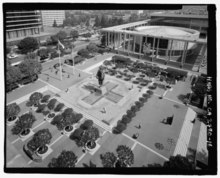
In some cities, especially in New England, the term "square" (as its Spanish equivalent, plaza) is applied to a commercial area (like Central Square in Cambridge, Massachusetts), usually formed around the intersection of three or more streets, and which originally consisted of some open area (many of which have been filled in with traffic islands and other traffic calming features). Many of these intersections are irregular rather than square.[17]
The placita (Spanish for "little plaza"), as it is known in the Southwestern United States, is a common feature within the boundaries of the former provincial kingdom of Santa Fe de Nuevo México. They are a blend of Hispano and Pueblo design styles, several of which continue to be hubs for cities and towns in New Mexico, including Santa Fe Plaza, Old Town Albuquerque, Acoma Pueblo's plaza, Taos Downtown Historic District, Mesilla Plaza, Mora, and Las Vegas Plaza.
In U.S. English, a plaza can mean one of several things:[18]
- a town square, as in the Spanish usage
- "any open area usually located near urban buildings and often featuring walkways, trees and shrubs, places to sit, and sometimes shops"[citation needed]
- a shopping center of any size
- a toll plaza, where traffic must temporarily stop to pay tolls
- an area adjacent to an expressway that has service facilities (such as restaurants, gas stations, and restrooms)
Today's metropolitan landscapes often incorporate the plaza as a design element, or as an outcome of zoning regulations, building budgetary constraints, and the like. Sociologist William H. Whyte conducted an extensive study of plazas in New York City: his study humanized the way modern urban plazas are conceptualized, and helped usher in significant design changes in the making of plazas. They can be used to open spaces for low-income neighborhoods, and can also the overall aesthetic of the surrounding area boosting economic vitality, pedestrian mobility and safety for pedestrians.[19] Most plazas are created out of a collaboration between local non-profit applicants and city officials which requires approval from the city.[20]
Throughout North America, words like place, square, or plaza frequently appear in the names of commercial developments such as shopping centers and hotels.
See also
[edit]References
[edit]- ^ The Adelaide Park Lands and City Layout (PDF). Australian Heritage Database: Places for Decision: Class: Historic. For consideration for National Heritage List. Australian Government. Dept for the Environment, Water, Heritage & the Arts. 9 July 2007. Archived from the original (PDF) on 22 October 2019. Retrieved 29 November 2019.
{{citation}}: CS1 maint: others (link) - ^ Anderson, Margaret (31 December 2013). "Light's Plan of Adelaide 1837". Adelaidia. Retrieved 29 November 2019.
- ^ Jones II, Philip J. (1997). "The Italian City-State: From Commune to Signoria". Oxford University Press. pp. 212–213. ISBN 0191590304.
- ^ "Piazza Della Signoria, Visit Florence". Visit Florence. Retrieved 18 December 2023.
- ^ "Piazza". Oxford American Dictionary. 2001.
- ^ "Mount Vernon, Piazza". Mount Vernon. Retrieved 18 December 2023.
- ^ Grevisse, Maurice; Goosse, André (2008). "543 Le type grand-mère.". le bon usage: Grammaire française (in French) (14 ed.). Bruxelles: De Boeck & Larcier. p. 703. ISBN 978-2-8011-1404-9.
Grand accompagne (avec trait d'union H2) des noms féminins dans quelques expressions figées : grand-croix, grand-maman, grand-mère [..].
En outre, des expressions cantonnées dans des vocabulaires spéciaux, grand-chambre, grand-garde, grand-hune, grand-salle, grand-voile ; – des emplois régionaux, comme grand-place, surtout courant dans le Nord de la France et en Belgique.
H2 543 Historique On a longtemps écrit grand'mère, etc. avec une apostrophe parce que l'on croyait qu'un e final avait disparu comme dans l'élision. C'est en 1932 que l'Ac. a remplacé par un trait d'union cette apostrophe injustifiée. - ^ Morris, Michèle R. (1988). "4.5.2 Cas d'élision". Mieux écrire en français: Manuel de composition et guide pratique à l'usage des étudiants anglophones (in French) (2nd ed.). Washington, D.C.: Georgetown University Press. p. 29. ISBN 9780878402250.
Le e de grande s'élide dans certains noms composés comme : grand-mère grand-tante grand-maman grand-duc grand-messe grand-rue grand-route grand-chose à grand-peine Observez que dans les noms précedent on utilise le trait d'union et non l'apostrophe (orthographe vieillie).
- ^ Florian Prouteau, Comment repenser nos places, centralités historiques remises en cause ? (in French), Sciences agricoles, 2013
- ^ "Ever-evolving Gwanghwamun to be altered anew". koreajoongangdaily.joins.com. 11 August 2015. Retrieved 3 January 2023.
- ^ "광화문광장". gwanghwamun.seoul.go.kr (in Korean). Retrieved 3 January 2023.
- ^ "A bigger and better Gwanghwamun Square Reopens!". Visit Seoul. Retrieved 3 January 2023.
- ^ Lodares Marrodán, Juan Ramón (2005). "Aventuras y desventuras etimológicas de Cerdá en torno a su "indicador urbano" de la urbanización". Ciudad y Territorio: Estudios Territoriales. 37 (144). Madrid: Ministerio de Fomento: 583. ISSN 1133-4762.
- ^ "Plaza". Reference.com. plaza. "plaza". Reference.com. πλατεῖα. Liddell, Henry George; Scott, Robert; A Greek–English Lexicon at the Perseus Project.
- ^ Regúnaga, Alejandra (2005). "Morfología derivativa: consideraciones en torno al uso de diminutivos en la ciudad de Santa Rosa (La Pampa-Argentina)" (PDF). Anclajes. 9. Santa Rosa: Universidad Nacional de La Pampa: 261. ISSN 1851-4669.
- ^ "plaza comercial". Linguee. Retrieved 22 February 2022.
- ^ Woodruff, Andy (16 June 2010). "Boston Squared". Andy Woodruff. Retrieved 30 July 2013.
- ^ "Plaza". Merriam-Webster Dictionary. 27 May 2024.
- ^ "Public Plazas". New York City DOT. Archived from the original on 7 September 2015. Retrieved 30 August 2015.
- ^ Bloomekatz, Ari (11 March 2012). "Silver Lake Gets an Unusual New Park Space". Los Angeles Times. Retrieved 10 October 2015.
